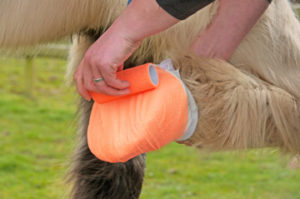Last summer, I came home after work to find my horse, Jimmy, limping in the field. To make matters worse, I had an early flight out of town the next morning. Why is it that animals always seem to have health problems right before you go on vacation? There were no scrapes or cuts on Jimmy’s leg, and he was able to put some weight on his foot, so I knew we weren’t making an emergency trip to the hospital. I figured it was most likely an abscess. I have had experience with a horse abscess before with Jimmy, so I checked for heat on the bottom of his hoof. There it was: heat radiating from the bottom of the foot that I could feel with my hand. With a few calls to the vet and the help of an awesome pet sitter (click here to read my article about finding a great pet sitter), I had a plan to care for his foot while I was away, and how to continue treating it when I came home.
An abscess is an bacterial infection of the connective tissues between the hoof wall and the sole of the foot. Abscesses can be caused by trauma to the hoof due to any number of causes, such a puncture wound, shoeing issues, or even a change of weather, such as going from extreme heat to moist and damp conditions. Because it is impossible for a horse to move without bearing weight on each leg, the constant pressure on an infected foot causes mild to harsh pain and can advance the infection. As the horse bears weight on the exposed area, bacteria travels up into the hoof cavity. The immune system sets off an inflammatory reaction in the area, causing a warm spot on the foot. White blood cells surround and kill the bacteria and begin to collect in the surrounding tissue. These white blood cells produce the pus generally accompanying hoof abscesses.
There are a few different ways to treat abscesses. Many choose to treat the hoof with an Epsom salt (magnesium sulfate) soak once or twice a day for 3 or 4 days. Add one cup of Epsom Salts per one gallon of warm water in a wide bucket. Stir vigorously, and let the hoof soak for 15-20 minutes to help draw out the infection.
For Jimmy’s abscess, we used an Epsom salt pack, followed by a Betadine/sugar pack. The following is an outline of the process:
For the first 3-4 days, an Epsom salt (magnesium sulfate) pack should be applied to the hoof. It is easiest to do a pack if you have a boot.
Follow these four simple steps:
- Apply a thin lay of cotton in the bottom of the boot
- Place ¼ inch of Epsom salt into the cotton
- Add enough water to make the salt into a paste-like consistency
- Keep pack on and change once per day for 3-4 days
After the initial 3-4 days, change over to a Betadine (povidone iodine) solution and sugar pack. This combination will toughen the hoof and draw out the abscess. Mix the two ingredients into a paste-like consistency – this is easiest done in a Tupperware container. Follow these four simple steps:
- Place a layer of the Betadine and sugar paste on the affected area
- Place a thin layer of cotton, or a diaper, over the paste on the foot
- Place the boot on, or wrap it with vet wrap (be careful to secure the wrap, but not so tight as to cut off blood flow to the hoof. Blood circulation is important for healing!)
- Continue this treatment once per day for 3-4 more days
The abscess should find its way to the surface of the hoof and rupture, providing much needed relief for the horse. If the condition improves, keep an eye on the foot and go about your routine as normal. If the hoof starts to worsen, call your veterinarian.
An everyday supplement, especially one with kelp and biotin, can also be used to help maintain normal hoof hardness, especially during the heavy rainfall that many states have been experiencing this season. My favorite is the Hoof & Coat Formula, which Jimmy gets a double dose of daily. He also gets Spirulina Wafers. Spirulina supports healthy kidneys and liver, which help remove toxins from the body, and supports a healthy immune system.

